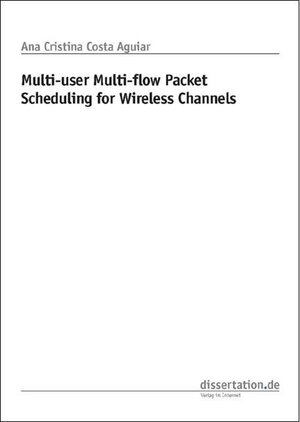
×
![Buchcover ISBN 9783866244009]()
Multi-user Multi-flow Packet Scheduling for Wireless Channels
von Ana C AguiarThis dissertation focuses on how to share a time-division multiplexed wireless channel among packets of different applications with different packet delivery requirements. The novelty of the approach lies in the goal of the allocation: improving user perceived application quality. The approach proposed is based on the paradigm that resource usage that does not improve user perceived quality is ineffective. Utility curves are used to map network service to perceived user quality, expressing the user sensitivity to delivered network service for each application. Based on the history of the network service delivered to a flow, the current perceived quality can be evaluated. Similarly, the quality increase achieved by transmitting a flow’s packet, and the quality decrease caused by the deferral of its transmission for some time, while another flow uses the channel, can be calculated. The packet scheduler proposed —PeLe— allocates the channel to the flow that maximises the sum of the overall quality after transmission of its packet. This accounts for the quality increase of the flow whose packet is transmitted and the quality decrease of the flows which have to defer transmission. The link quality is reflected by the duration of a packet’s transmission, which depends on the usable transmission rate; a low link quality requires the use of a robust modulation and coding scheme, which causes a longer channel occupation time. This causes a larger degradation of other flows’ quality if that packet is scheduled and leads to a lower overall quality after the transmission.
The behaviour and performance of the PeLe scheduler are studied using discrete-event simulations with realistic traffic models for four traffic types: bulk file transfers, web traffic (both using an implementation of TCP New Reno), VoIP calls and H.264 variable bit rate video streaming. The performance of the scheduler is evaluated using application-specific metrics for user perceived quality. The fast fading of the links used in the evaluation is modeled using measurement traces obtained from a WLAN channel measurement campaign in low mobility environments carried out for the purpose. The results show that the PeLe scheduler provides a higher average number of satisfied users than the reference schedulers, at a maximum cost of 12% lower overall channel throughput.
Channel-adaptive mechanisms require a prediction of the wireless link behaviour at the transmitter. This dissertation studies the accuracy of the One Step (OS) prediction heuristic, which assumes the received signal stays constant at the last measured values, and compares it with 3 alternative prediction methods using the WLAN measurement traces. The OS heuristic shows the lowest mean squared prediction error up to horizons of 2 ms; beyond that horizon the prediction performance of all studied mechanisms is comparable to a moving average. The impact of the prediction errors in an adaptive rate scheme is that in up to 30% of the times a less robust modulation than required is chosen. That leads to an increase of an order of magnitude in packet loss rate. Finally, the impact of the link prediction errors on the performance of opportunistic packet schedulers is studied. The results show that the PeLe scheduler is less sensitive to link prediction errors than opportunistic schedulers because the scheduling metric defined only indirectly takes the link quality into account.
Altogether, the results obtained in this work show that the approach proposed can improve the user perceived performance of wireless communications under realistic traffic and system conditions.
The behaviour and performance of the PeLe scheduler are studied using discrete-event simulations with realistic traffic models for four traffic types: bulk file transfers, web traffic (both using an implementation of TCP New Reno), VoIP calls and H.264 variable bit rate video streaming. The performance of the scheduler is evaluated using application-specific metrics for user perceived quality. The fast fading of the links used in the evaluation is modeled using measurement traces obtained from a WLAN channel measurement campaign in low mobility environments carried out for the purpose. The results show that the PeLe scheduler provides a higher average number of satisfied users than the reference schedulers, at a maximum cost of 12% lower overall channel throughput.
Channel-adaptive mechanisms require a prediction of the wireless link behaviour at the transmitter. This dissertation studies the accuracy of the One Step (OS) prediction heuristic, which assumes the received signal stays constant at the last measured values, and compares it with 3 alternative prediction methods using the WLAN measurement traces. The OS heuristic shows the lowest mean squared prediction error up to horizons of 2 ms; beyond that horizon the prediction performance of all studied mechanisms is comparable to a moving average. The impact of the prediction errors in an adaptive rate scheme is that in up to 30% of the times a less robust modulation than required is chosen. That leads to an increase of an order of magnitude in packet loss rate. Finally, the impact of the link prediction errors on the performance of opportunistic packet schedulers is studied. The results show that the PeLe scheduler is less sensitive to link prediction errors than opportunistic schedulers because the scheduling metric defined only indirectly takes the link quality into account.
Altogether, the results obtained in this work show that the approach proposed can improve the user perceived performance of wireless communications under realistic traffic and system conditions.


